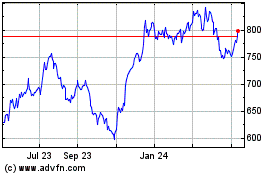U.S. Labor Department Curbs Sustainable Investing in 401(k)s
October 30 2020 - 5:04PM
Dow Jones News
By Dieter Holger
The U.S. Department of Labor issued a rule that could curb
investing in 401(k)s based on environmental and social issues, a
measure that was opposed by money managers who are rapidly building
out environmental, social and governance funds to meet rising
demand.
First proposed in June, the final rule published on Friday
requires that funds in retirement plans only consider
risk-and-return for stocks and bonds and not other environmental or
social issues. Sustainable funds often target greenhouse gas
emissions, labor practices or gender and race relations.
"This rule will ensure that retirement plan fiduciaries are
focused on the financial interests of plan participants and
beneficiaries, rather than on other, non-pecuniary goals or policy
objectives," said U.S. Labor Secretary Eugene Scalia.
Still, a senior department official said funds that consider
environmental and social issues could be allowed if managers
document how the strategy benefits the core risk-and-return
objective.
"This does not mean that fiduciaries are prohibited from
considering such issues as environmental impact and workplace
practices," the official said.
There could be also "rare circumstances" that an investment with
environmental or social goals is indistinguishable economically
from a competing option. In those cases, a fund manager could weigh
those factors but must show how the financial interests of savers
aren't sacrificed.
Only one of the 86 asset managers who sent letters over the
30-day comment period supported the rule, according to an analysis
by trade group US SIF: The Forum for Sustainable and Responsible
Investment and other organizations. The report found that 95% of
8,737 comments opposed the proposal.
Many said the proposal singles out sustainable investments
unfairly for heightened scrutiny, unnecessarily burdens investment
firms and is based on a flawed idea that sustainability factors
sacrifice returns.
"The proposal creates an overly prescriptive and burdensome
standard," BlackRock Inc., the world's largest money manager, said
in its comment to the department.
Sustainable funds, typically based on environmental, social and
governance data that companies report, are still sparse in
retirement plans, but big money managers--like Fidelity Investments
Inc. and Natixis SA--have said they want to offer more of the funds
to savers.
In 2018, only 2.8% of 401(k)s offered an ESG fund in their
lineups, representing a largely untapped market for fund managers,
according to the American Retirement Association's Plan Sponsor
Council of America, a trade group.
Despite the novelty of sustainable investments in 401(k)s,
individual investors are buying into the funds. In the third
quarter of this year, the U.S. saw a record $9.8 billion flow into
sustainable funds, bringing total assets to $179.1 billion.
"Today's decision is unwelcome by pension funds and other
fiduciaries and runs counter to global market trends and the
mainstream U.S. and global practice of integrating ESG factors into
investment decisions," said Mindy Lubber, chief executive of
sustainable investing nonprofit Ceres, which hosts a network of 175
investors representing $30 trillion.
"This decision will impair the ability of pension funds to
consider the short- and long-term financial risks posed by extreme
weather, water shortages and human rights abuses in performing
their investment analysis and allocations," she added.
Analysts said the rule could be reversed, depending on the
outcome of next week's U.S. presidential election.
"The ESG pendulum appears to swing based on which political
party occupies the White House," said Vadim Avdeychik, a lawyer
specialized in investment management at Paul Hastings LLP.
Write to Dieter Holger at dieter.holger@wsj.com;
@dieterholger
(END) Dow Jones Newswires
October 30, 2020 16:49 ET (20:49 GMT)
Copyright (c) 2020 Dow Jones & Company, Inc.
BlackRock (NYSE:BLK)
Historical Stock Chart
From Mar 2024 to Apr 2024

BlackRock (NYSE:BLK)
Historical Stock Chart
From Apr 2023 to Apr 2024
